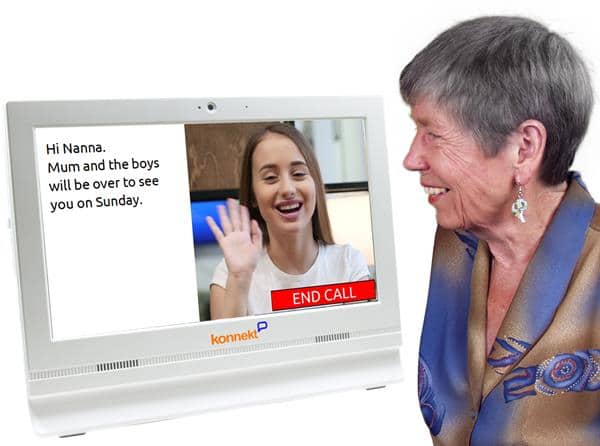Written by John Nakulski, Jun 2023:
Lip reading, also known around the world as speech-reading, is a valuable skill for individuals who are either Deaf or hard of hearing, as well as for their carers and family members. It allows individuals to understand speech by interpreting the movements of the lips, tongue, and facial expressions. It is an important skill not only for those who want to improve their communication and access to information, but also for those who lose hearing over time.
However, it’s important to acknowledge that learning to lip read can be challenging, and it may take time and practice to become proficient. This can be especially challenging for those who become Deaf or hard-of-hearing suddenly, due to age or illness.
In this article, we’ll take a look at some of our top tips for assisting either yourself or a client to learn lip reading skills, as well as some practical steps you can take if supporting someone who is Deaf or hard-of-hearing.
How many people need to lip read?
While percentages vary across the world, the latest research demonstrates that an increasingly significant proportion of people are now living with some degree of hearing loss.
- According to the Australian Bureau of Statistics, around 4% of Australians have a severe or profound hearing loss
- For those living in the United States, the National Institute on Deafness and Other Communication Disorders reports that around 15% of American adults (37.5 million) aged 18 and over have hearing loss in both ears
- In the United Kingdom, the National Deaf Children’s Society estimates that 1 in 6 children have some degree of hearing loss – of course, many of these children grow up to be hearing-impaired adults

Here, it’s important to note that people with slow-onset hearing loss do tend to “subconsciously” learn the skill of lip-reading over time – however, this does not reduce the distress of general misunderstandings, or failing to keep up with other forms of communication.
Moreover, learning to lip read has become a skill that’s now more important than ever before. While the use of communications technology has increased across the world due to both technological advances and the advent of COVID-19, such devices still present ample challenges for those who find hearing to be difficult.
Tips on learning to lip read
Here are some tips for learning to lip read, as well as for assisting someone in your life who is Deaf or hard-of-hearing to communicate with ease:
1. Start with basic words and phrases
Begin by learning to lip read common words and phrases such as “hello,” “goodbye,” “yes,” and “no.” As you become more comfortable, you can move on to more complex words and sentences.
2. Watch videos
There are many lip-reading tutorials and videos available online. Why not watch these videos and practise lip-reading along with the speaker?
3. Use captioning communications technology
Learning to lip read can be challenging.
However, one of the easiest and most dignified ways to transition into the process can be to enlist the help of purpose-created assistive communications technology such as the Konnekt Captioning Videophone.

With a variety of impressive features such as “one touch to call” function, extra-large touch-screen and volume capability, and the ability to call any device including mobile telephones, the Konnekt Captioning Videophone also “reads” the voice of any caller, producing super-fast and accurate captioning in multiple languages.
What our customers tend to report is that people with moderate to severe hearing loss and advanced lip-reading skills tend to use the Konnekt by listening and watching the face, using captions only to fill in gaps.
On the other hand, those with profound hearing loss generally stay focused on captions, but subconsciously do read lips and facial expressions as well. With video calling, it is also easier for them to tell (by observing the other person’s mouth) when it’s your turn to talk!
You can read about customers’ experiences using the Konnekt Captioning Videophone here.
4. Practice with a partner
Find a friend or family member who is willing to practice lip-reading with you. This will give you the opportunity to practice in a real-life setting and receive feedback on your skills.
5. Attend a lip-reading or sign language class
Many organizations, such as the Royal Association for Deaf people in UK and the National Association of the Deaf in the US offer lip-reading classes. These classes will provide you with the opportunity to learn from an experienced teacher and practice with other students.
6. Practice regularly
Like any skill, lip-reading requires practice to become proficient. Set aside time each day to practice lip-reading, even if it’s just for a few minutes.
7. Be patient with yourself and your loved ones
Learning to lip-read can be challenging, and it may take time and practice to become proficient. Be patient with yourself and don’t get discouraged.
It is important to note that lip-reading is not a substitute for hearing, but it can help to improve communication and access to information for individuals who are Deaf or hard of hearing.
Tips for helping loved ones learn to lip read
If you’re in the position of caring for someone who is Deaf, hard-of-hearing or learning to lip read themselves, there are many steps you can take to ensure your communication is as effortless as possible.
What to do during conversations
- Speaking clearly and at a moderate pace
- Maintaining eye contact and avoiding moving your body or covering your mouth while speaking
- Using facial expressions and gestures to complement your speech
- Repeating or rephrasing if the person is having trouble understanding
- Regularly checking in and asking for feedback on your communication strategies

When communicating with individuals who are deaf or hard of hearing, it’s important to approach the interaction with patience and understanding. Recognize that they may face difficulties and frustrations, and provide them with the support they need.
You could:
- Practice patience and being understanding of any difficulties and frustrations that may arise
- Make sure you have the person’s attention before speaking
- Encourage the person to take lip reading classes or seek professional help
- Be respectful of the person’s deafness or hard-of-hearing, and refrain from raising your voice as it can be perceived as yelling
Lastly, nonverbal support is essential for effective communication with individuals who are deaf or hard of hearing. Facial expressions, gestures, and body language serve as valuable tools to convey meaning and enhance understanding, bridging the communication gap for a more inclusive interaction.

Examples of Nonverbal Support
- Learn some basic sign language to improve communication and understanding
- Minimizing background noise and distractions
- Using written or visual aids if needed
- Use hearing aids, captioning, or amplification devices to assist in communication
- If possible, get a professional interpreting or captioning service to help facilitate communication
Wrapping up
In conclusion, lip-reading is a valuable skill for individuals who are Deaf or hard of hearing.
However, learning to lip read can be challenging and may take time and practice. While the above tips can help to improve your lip reading skills and ability to provide support to those who need it, it remains important to consider reaching out to professional organizations and organized classes providing both specialist support and the opportunity to learn from an experienced teacher.
To find out more about Konnekt’s products or to have an obligation-free discussion with our team about best-fit options for you and those you love, visit our website and we’ll get in touch.
References:
- “Estimates: Disability and Hearing”, Australian Bureau of Statistics
- “How many children are deaf or have hearing loss?”, National Deaf Children’s Society
- “Quick statistics: hearing”, National Institute on Deafness and Other Communication
- “Read Our Lips Australia – Resources”, Deafness Forum
